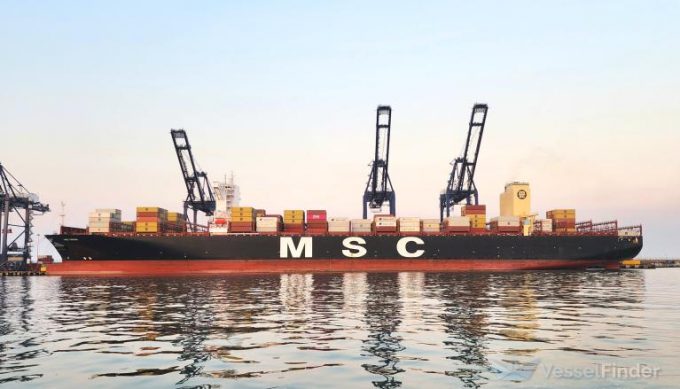After stellar ZIM delivery, it's 'happy birthday' to the Red Sea crisis
One year of joy for some
BA: WIND OF CHANGEMAERSK: BULLISH CALLXPO: HEDGE FUNDS ENGINEF: CHOPPING BOARDWTC: NEW RECORDZIM: BALANCE SHEET IN CHECKZIM: SURGING TGT: INVENTORY WATCHTGT: BIG EARNINGS MISSWMT: GENERAL MERCHANDISEWMT: AUTOMATIONWMT: MARGINS AND INVENTORYWMT: ECOMM LOSSESWMT: ECOMM BOOMWMT: RESILIENCEWMT: INVENTORY WATCH
BA: WIND OF CHANGEMAERSK: BULLISH CALLXPO: HEDGE FUNDS ENGINEF: CHOPPING BOARDWTC: NEW RECORDZIM: BALANCE SHEET IN CHECKZIM: SURGING TGT: INVENTORY WATCHTGT: BIG EARNINGS MISSWMT: GENERAL MERCHANDISEWMT: AUTOMATIONWMT: MARGINS AND INVENTORYWMT: ECOMM LOSSESWMT: ECOMM BOOMWMT: RESILIENCEWMT: INVENTORY WATCH

MSC set a new record for its share of ocean carrier capacity last month, with the latest data confirming that the ‘top 10’ carriers still command the sector.
Geneva-based MSC reached a record share of 19.8% of the global operated container fleet at the end of July, according to Alphaliner. It has added some 400,000 teu to its fleet this year, reaching the highest capacity ever recorded by a single carrier.
According to Alphaliner, only Danish carrier Maersk has ever “come close to dominating the market in the same way”.
It added: “Maersk reached a peak share of 19.4% in 2018, but has seen its market participation decline in each of the five consecutive years since then.”
Meanwhile, MSC has orders for newbuildings from Chinese shipyards that will take its fleet to 7.5m teu by 2028. And, according to Linerlytica’s latest report, released yesterday, the carrier is set to order ten 21,000 teu vessels from Jiangsu Hantong Ship Heavy Industry, with deliveries estimated to take place from late 2027 to 2028.
Also, besides these, MSC has reportedly commissioned several 11,000 and 12,000 teu vessels at Penglai Zhongbai Jinglu Ship Industry, adding to the 1.2m teu already in its oprderbook.
The newbuilding price was not disclosed, but according to VesselsValue, the newbuilding prices are estimated at $300m for a 21,000 teu ship, $193m for 12,000 teu ships and $192m for 11,000 teu units.
Last week, MSC also took delivery of two second-hand ships, the 4,253 teu Alexander Bay (built 2003) and 4,229 teu Kilimanjaro (built 2006), from Idan Ofer’s XT Shipping, for $18.5m and $20m, respectively. In May, MSC acquired two 14,000 teu newbuilding resales from BAL Container Line.
Rival Maersk has opted to cap its fleet size in favour of non-shipping growth, and in April confirmed its target fleet range of 4.1m to 4.3m teu.
“This will inevitably curb its market share at a time of rapid growth by competitors, notably MSC and CMA CGM,” Alphaliner said, and noted that five of the top 10 carriers had orderbooks bigger than Maersk’s.
It warned: “The [Maersk] group could come under pressure from shareholders for the strategy if financial returns do not improve, with the group’s preliminary figures for Q2 indicating an operating margin of <4% for H1 24, below its long-term target of >6%, despite the Red Sea crisis.”
However, it was reported that Maersk is acting to recover some lost market share, with plans to order a dozen 16,000 teu LNG dual-fuelled ships, and is said to have committed to a long-term charter of five 16,800 teu LNG dual-fuelled ships commissioned by John Fredriksen’s SFL Corp at China’s New Time Shipbuilding.
Meanwhile, three other carriers have increased their share of available capacity compared with a year ago. Israel’s Zim’s capacity overtook that of Taiwan’s Yang Ming for the first time since 2011, after increasing its share by 0.2% to 2.4% and, according to Alphaliner data, Japan’s ONE increased its share from 5.9% to 6.4%, year on year and Hapag-Lloyd saw a rise from 6.8% to 7.2%.
Meanwhile, the top 10 carriers continue to dominate the container shipping market, offering 83.9% of total global operating capacity at the end of July – just 0.01% from last year’s 84%.
Although CMA CGM’s newbuild delivery pipeline will see it surpass Maersk by 2027, it will still trail MSC by more than 2m teu by the end of 2028. That said,
Comment on this article